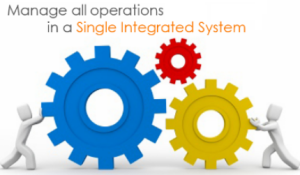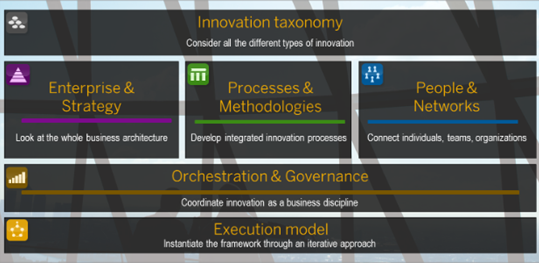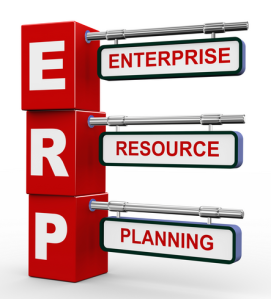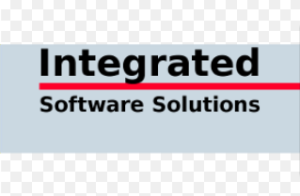 What is striking me recently is the upsurge in the software being specifically designed for managing innovation within our organizations.
What is striking me recently is the upsurge in the software being specifically designed for managing innovation within our organizations.
The competition seems to be warming up in the more ‘standalone’ out-of-the-box segment and the innovative tools being provided are certainly accelerating the innovation process.
The software being provided is going well beyond the simply mining and capturing of promising ideas. The solutions are moving into sound idea enrichment, evaluation processes and managing a portfolio of innovation in more holistic ways.
The providers here, namely Hype, Brightidea, Spigit, Imaginatik and a growing group of others have been significantly improving their ‘front end’ offerings to capture and develop concepts
They are increasingly turning their attentions to the ‘back end’ and support with a greater focus on governance, knowledge repositories, campaign cockpits, evaluation and dialogue exchange mechanisms. Mobility has also been a growing feature to capture innovation ‘on the go’.
Will we see Emerging Enterprise Solutions for greater integration?

The change that we are beginning to see emerge is the growing interest in innovation management software from the bigger
Enterprise integrators. In particular, I have become more aware of the advances taking place in managing innovation from SAP, or the potential promise yet to emerge.
I have been working through a presentation made by Marco Cigaina from SAP’s Global Services Innovation group recently and felt the concept outlined was beginning to frame innovation and its management in a solid way.
One that can potentially move software solutions into a structured, comprehensive and consistent set of concepts to build around for innovative applications.
I’m not sure if SAP is advancing this as their innovation roadmap or it was just a conceptual framework offered by part of the organization to explore and contribute to thinking. I want to learn more as I think it has some potential.
They (well at least Marco) are calling this (at present) the Innovation Management Framework building upon applicable foundations of knowledge for innovation management and working towards an overarching execution model.
Judge for yourselves on this suggested innovation framework.
You can watch the video here, it is about 50 minutes offered up as a workshop from the SAP University Alliances led by Marco Cigaina. He has also written a book on this, go here to find out more.
The Innovation Management Framework presented in this book and workshop articulates innovation management in a structured and consistent set of concepts and practices, and focuses on their concrete applicability to the objective of enabling and fostering innovation in established companies. It provides a sound starting point in my opinion.
Here is the Innovation Management framework.

So what is making up the thinking that goes into each of these sections on what this framework seems to offer?
For me, it certainly feels to have advanced the potential for innovation to eventually become a fully integrated SAP solution
It has six aspects within this.
- It starts out to build the innovation taxonomy and where a common language and the critical capability aspects begin to be formed. It is suggesting to frame around innovation capabilities, projects and outcomes and looks to focus on scope, scale, perspectives, impact and discontinuity aspects. It needs to build processes, methodologies, tools, business context, strategy and architecture for managing this for individuals, teams, organizations and networks. I like this as a higher level entry point.
- Then they suggest you move through the enterprise and strategic needs and layer different aspects of the Enterprise, Strategy, the Business Model, the Business Process, the Solutions, Technology and competencies needed. This part, for me, remains a little thin but does attempt to capture the different levels of the enterprise’s need and strategy to link into and flow. I would argue my outlined Executive Innovation Work Map framework would be useful here to ‘flesh’ this part out further, plus other thoughts I feel can be built into this part.-
- Then you move into processes and methodologies. The classic search and idea through to commercialize and monetize these. The structure of passing through evaluation and selection and then implementation is sketched out. The underlying structuring into research, ideation and creative methodologies, collaborative processes and tools, design thinking, IP management, Knowledge management, new solution development, project management to commercialization offer a beginning of a well- thought through a phase to allow distinct processes and methodologies that can still cater well for different Enterprise needs.
- Then the People and Networks draw in systematically all the partners, influences, institutions, crowdsourcing, customers and lead users and they are highlighting company culture, open innovation and structuring this again into a taxonomy making this a far more advanced approach to managing innovation today than what I have heard before. It reflects a more up to date view and the importance of people, their relationships and the networks you need to build and exploit for innovation.
- The part that I particularly like is the Orchestration and Governance section. It frames these into vision and strategy, the governance roles, a section called the initiatives management one where portfolio management sits alongside venture management. The other key aspect I really like is the focus on organizational learning where you manage through a maturity model and equally feed into the knowledge repository and finally with metrics associated with these to manage and monitor the innovation activity.
I certainly believe orchestration and governance is badly undervalued by many organizations within their innovative approaches and this would advance the thinking and give orchestration and governance its place of critical importance by offering this component within any innovation framework. I’ve written about the role of governance a few times, as well as the importance of orchestration, so I welcome this more dedicated focus.
- Lastly, the Execution model covers set-up structures, analyse and design, planning, execution and evaluation steps. This is to be regarded as iterative in approach. Again, treating execution as a standalone step I think has real added value focus. I’ve learnt that execution is a rugged terrain full of as much a need for concerted leadership as the other parts of innovation and its management. One aspect is building a sustaining execution machine and is the final frontier in managing and delivering innovation successfully.
The really potential promise of Enterprise Integration
 The other part of the thinking and certainly critical within any SAP solution would I assume, be any innovation system that needs to integrate into other information systems and processes.
The other part of the thinking and certainly critical within any SAP solution would I assume, be any innovation system that needs to integrate into other information systems and processes.
That is the strong selling point of SAP, its focus on integration, although ‘the cloud’ might be challenging this and altering this possibly.
If SAP can achieve that ability to integrate this into being part of the Enterprise solutions then we do have many of the existing impediments to innovation adoption melt away. Offering an integrated solution would really offer innovation and its management a real opportunity to become fully embedded within our organizations.
As I said, I’m not sure where SAP is in actually realizing this Innovation Management Framework. All I can feel it has a real potential to expand and explore further as an overarching approach.
This potential framework is certainly viewing IM in a more holistic way, it is moving beyond ‘just’ ideas management or standalone components, often like PLM, or PPM and would significantly advance innovation to be fully embedded within our organizations.
We really do need to resolve this growing need to get technology and systems ‘talking’ innovation, to establish their position and integrity and have integrated interfaces into a total ERP system.
Innovation management today is often standing outside any integration structure. Some may argue it should do but I do think innovation is often missing the critical line of top management sight and suffers accordingly in numerous constraints.
Lacking this holistic understanding of innovation often makes it hard for top management to gain the confidence or be supplied with their required view of innovation and all that is associated with it. They want and expect a clear line of sight. We spend far too much time trying to connect innovation to the Enterprise.
Can this change? I believe we are getting closer to a point of having integrated software solutions for innovation.

If innovation management can be integrated into the organization’s systems many of the current problems, barriers and issues surrounding innovation might begin to melt away or change the existing unsatisfactory result game of today.
Innovation has many touchpoints, and a myriad of dimensions that need to be aligned and integrated and I genuinely believe the software provider who takes a more holistic view of innovation management can make a significant advancement in where we are today.
I simply like these perspectives offered by Marco through his research and work undertaken with SAP and feel it does makes a very credible initial attempt to frame innovation in a well-thought-out way. What do you think?
Great Post Paul….
SAP is a great client of ours.
Here are some of the public sites that are part of there Innovation programs:
https://ideas.sap.com/
https://ideas.sap.com/ct/c_ent_homex.bix?a=OD5268&level_id=36F0B80C-DFFF-42D4-8400-9FBBDD6EFAE5
Best,
Vincent
SAP has been leveraging Brightidea innovation management software for years to facilitate co-innovation with SAP and its customers, partners and ecosystem in the pursuit of disruptive innovation. You can learn more about some of SAP’s truly inspired innovation program initiatives on their co-creation site ‘Idea Place’: https://ideas.sap.com/
Hi Paul, good post here. Appreciate the write up on SAP’s framework. It feels a little late in the game for SAP to be launching a V1 innovation management solution, but at HYPE we welcome it, especially if the focus is on taking a more holistic and integrated view on innovation management. Anything that helps to broaden the market and the understanding of where we can go with this, is a good thing.
But – I do wonder how potential customers will view this offering. The leading vendors in the market know one thing is true: you need to be agile and fast to support the changing innovation ‘needs’ of clients. HYPE, BrightIdea, Spigit, are well versed in this agility and being responsive (I don’t just mean in software terms). But SAP is not really known for being agile. Can they really offer rich support for innovation? Let’s see!